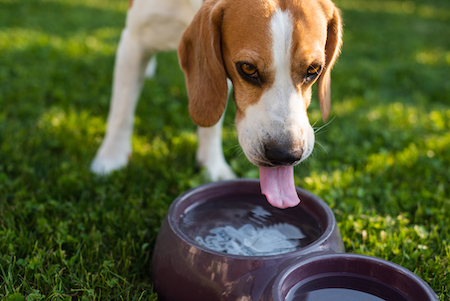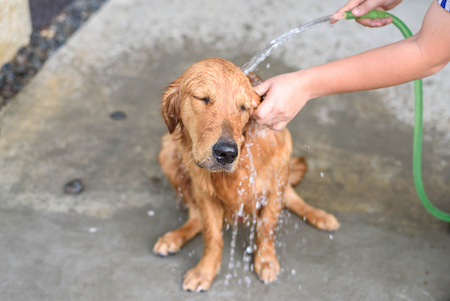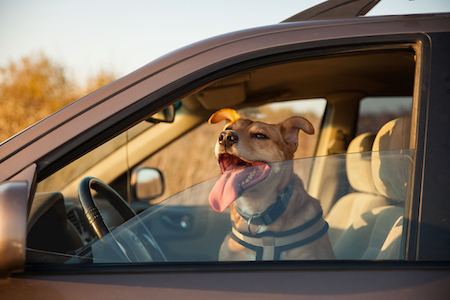How to Prevent Heat Stroke in Dogs
Posted: 09/08/2022 | BY: Erin Cain | Categories: Dog , Health problems , Pet care
This year, more dog owners are inviting their canine companions to participate in outdoor fun with their families. The great outdoors offers dogs a wealth of mental and physical stimulation opportunities. Still, exposure to high temperatures, high humidity, and long periods spent outside can lead to heat stroke in dogs, a prescription for disaster. Heat stroke is a potentially fatal ailment that can affect a dog if subjected to extreme heat and temperatures. Knowing this problem and its causes can help prevent heat stroke in dogs.

What precisely is heat stroke in dogs?
The potentially fatal condition known as heat stroke occurs when a dog’s natural heat-dissipating mechanisms are overwhelmed by extreme heat and are unable to function correctly. When it becomes too hot, dogs use one of two natural cooling mechanisms to keep themselves from overheating. Canines not only sweat through their paws, but they also use panting as a method for regulating their body temperature. In high heat, though, these mechanisms can only accomplish so much.
Heat stroke often manifests when a dog’s core body temperature rises above 105.8 degrees Fahrenheit. However, reaching that precise temperature is not required for a dog’s heat stroke to start.
How does heat stroke affect dogs?
Extremely high temperatures or prolonged exposure to the heat can cause a dog’s bodily systems to become dysfunctional, raising the dog’s risk of passing away. In addition to this danger, heat stroke manifests itself in a variety of ways in canines. Some dogs may suffer from life-threatening illnesses of the blood and cells and cardiac and renal conditions. Other dogs may endure organ dysfunction.
Heat stroke is a disorder that frequently affects dogs and can occur very rapidly. This fact is especially true in surroundings with high temperatures and high humidity levels and locations with little to no ventilation. The natural cooling systems of a dog might be compromised or rendered entirely ineffective when exposed to humidity levels between 35 and 80%.

What happens to a dog suffering from heat stroke?
When a dog suffers from heat stroke, the following physiological processes become impaired:
- The dog’s brain will expand and may bleed in some spots if the temperature continues to climb.
- Gastrointestinal dysfunction arises.
- The dog’s heart increases its cardiac output, and its blood vessels expand, which puts the dog in danger of cardiac arrest.
- Failure of the kidneys occurs, as well as damage to the liver and muscles, which can result in death or lifelong disability.
Exertional and non-exertional heat stroke are both possible forms of heat illness that can affect dogs. Let’s look at the various types of heat stroke that can affect dogs and how they develop.
Exertional heat stroke in dogs
Exertional heat stroke happens when dogs engage in physical activity (such as running, strolling, or playing) in temperatures too high for their bodies to react appropriately. Dogs that have not been allowed to acclimatize to their environment are more likely to suffer from this form of heat stroke. It takes dogs around three months to adjust to warmer climates. Their well-being and health need gradual exposure to warmer temperatures and higher humidity levels.
Non-exertional heat stroke in dogs
Non-exertional heat stroke happens when a dog cannot cool down due to increased temperatures in areas with decreased airflow. These areas include places like a home or apartment that does not have air conditioning, a closed and locked car, or a yard or park that does not have adequate shade or water.
What are the symptoms of heat stroke in dogs?
Many indications and symptoms can indicate whether or not a dog is suffering from heat stroke. Any one of the following symptoms may be present in a dog that is affected by this condition:
- Panting excessively
- Fever and feeling warm to the touch
- Hypersalivation (excessive drooling with thick, ropey saliva)
- Rapid pulse
- Lethargy
- Confusion
- Concentrated, dark urine
- Vomiting
- Diarrhea (tarry and black)
- Staggering (ataxia) or inability to walk
- Nasal dryness
- Bleeding from the mouth or the bowels
- Tingling, twitching, tremors, and weakness in the muscles
- Experiencing collapse or fainting
- Bright red gums
- Cardiac arrest
- Coma
- Seizure
- Death (generally within 24 hours)

Which dog breeds are more likely to suffer from heat stroke?
Some breeds of dogs are more susceptible to heat stroke than others. It’s common knowledge that puppies younger than six months, older dogs, and overweight and obese dogs struggle more in warm weather, which puts them at risk for heat stroke. Dogs on certain medications, as well as canines who already have lung or heart illnesses, increase the likelihood of heat stroke. If your dog has suffered from heat stroke in the past, he is at an increased risk of experiencing it again.
The danger of heat stroke increases in dog breeds with dense, heavy coats, such as the Siberian Husky and the Malamute. The same principle applies to dog breeds that have what is known as “double coats,” such as the Chow Chow, the Labrador Retriever, and the Golden Retriever. Insulators and heat trappers, the highly dense and double coats, pose a risk to these pups because of the combination of the two properties.
The brachycephalic dog breeds are among the worst in high heat and humidity and may be at the greatest danger of heat stroke. This group of dogs includes a variety of breeds, some of which are the Pug, the French Bulldog, the Boston terrier, and the Cavalier King Charles Spaniel, among others. What characteristics do these different breeds share in common? Their flat faces make it more challenging to pant and eliminate excess heat when the temperature is high. The warmer the surrounding temperature, the more effort these dog breeds put into panting and breathing. Heat stroke is a common cause of death for these canines with flat faces.

What is the recommended treatment for heat stroke in dogs?
What should you do if you suspect your dog is suffering from heat stroke? Because every second counts in this scenario, it is imperative that you act swiftly to assist your dog by following these instructions:
For dogs immediately stricken by heat stroke:
- Immediately take your dog to the nearest emergency animal hospital or veterinarian if these symptoms are present:
- Your dog is unresponsive, has collapsed, or is having a seizure;
- Your dog has visible injuries, such as bleeding;
- Your dog is vomiting or experiencing diarrhea, and there is no access to cool water.
For dogs with heat stroke who are conscious and responsive:
2. Relocate your dog to a shady, cool area or an air-conditioned setting;
- Put a damp blanket or towel that is cool below your dog.
- If the dog is awake and can drink water, give him small amounts of cool water frequently. Do not let him drink too quickly because this can result in other medical disorders, and do not give him frigid water;
- Make a note of the time you start treating your dog so that you may inform your veterinarian of the amount of time since the dog first had symptoms of heat stroke;
- Take your dog’s temperature using a rectal thermometer if you have one available. If the dog’s fever is more than 104 degrees Fahrenheit, you should sponge, spritz, or hose down his body with cool water;
- If you have access to a fan in the area, you should direct it toward your dog and allow the breeze to blow over him. You should stop spraying when your dog’s temperature falls to 103.5 degrees Fahrenheit. Do not continue to chill your dog beyond this stage since he could go into greater shock;
- Make a note of the time you cease chilling your dog, again for your veterinarian’s reference and your dog’s continued medical treatment in the future.
- You may prevent your dog from experiencing excessive cooling by using a dry towel or blanket to pat them down after washing;
- You should take your dog to the emergency animal hospital or veterinary clinic closest to you for additional medical attention.
A visit to the veterinarian should always be the last resort. If you have any reason to suspect that your dog needs medical attention, do not hesitate to take him to the local veterinary clinic.

How can you prevent heat stroke in dogs?
The most effective protection against canine heat stroke is knowledgeable pet parents. You can lessen the odds that your dog will suffer from heat stroke by doing the following:
- Getting your dog used to high weather might take up to two months.
- Never, not even for a few seconds and not even with the windows cracked, should you ever leave your dog alone in a parked automobile.
- Ensure you only take your dog out for walks during the shadier portions of the day (early morning and later evening).
- When taking your dog outside, you should make sure he has access to lots of fresh water to drink as well as some shade.
- Maintain a cool temperature in your home. If you have air conditioning, ensure it runs even when you are not there so your dog can stay comfortable.
When your dog is inside and outside, look for the signs and symptoms of heat stroke and pay close attention to him.

Pet insurance helps you and your dog in an emergency.
Any dog is susceptible to suffering from heat stroke, and taking your pet to the emergency veterinary facility during a crisis could cost you thousands of dollars. Make sure your dog is covered by a pet insurance plan so that you don’t have to worry about the cost of his treatment and can focus on his well-being instead. Get a free quote, and Pet Insurance Review will find the best policies for you and your dog.
References:
- Mayer, J. (2017). How Animals Keep Their Cool. Retrieved from https://www.sciencefriday.com/articles/animals-keep-cool/
- Kruzer, A. (2021). How Hot Is Too Hot for Dogs? Retrieved from https://www.thesprucepets.com/what-is-too-hot-for-dogs-3975543
- Clancy, M. (2022). Why Summer Heat Can Be Deadly For Brachycephalic (Short-Muzzled) Dogs. Retrieved from https://dogtime.com/how-to/pet-safety/53229-summer-heat-deadly-brachycephalic-dogs
- Burke, A. (2019). Can I Leave My Dog in the Car If I Crack a Window? Retrieved from https://www.akc.org/expert-advice/health/dogs-in-hot-cars/
The information contained on this blog is intended for informational and educational purposes only and should not be construed as medical advice. It is not a substitute for professional veterinary care. Always consult with your veterinarian before making any changes to your pet's health care or treatment plan.
The authors of this blog are not veterinarians and do not claim to be experts in pet health. The information provided here is based on our own experiences and research, as well as information from reputable sources. However, we cannot guarantee the accuracy or completeness of this information.
We encourage you to do your own research and consult with your veterinarian before making any decisions about your pet's health.
Previous post
The Benefits of Pumpkin for DogsCompare top pet insurance providers & plans.
Enter your dog’s age in years and months to calculate their age equivalent to human years.
Calculate your dog’s ageEnter your cat’s age in years and months to calculate their age equivalent to human years.
Calculate your cat’s age